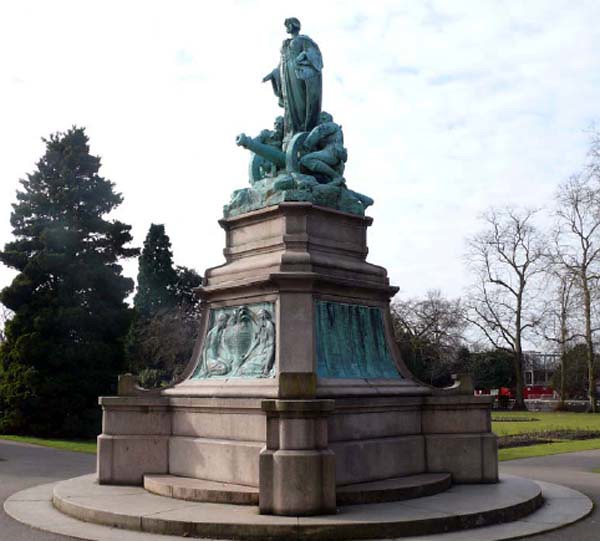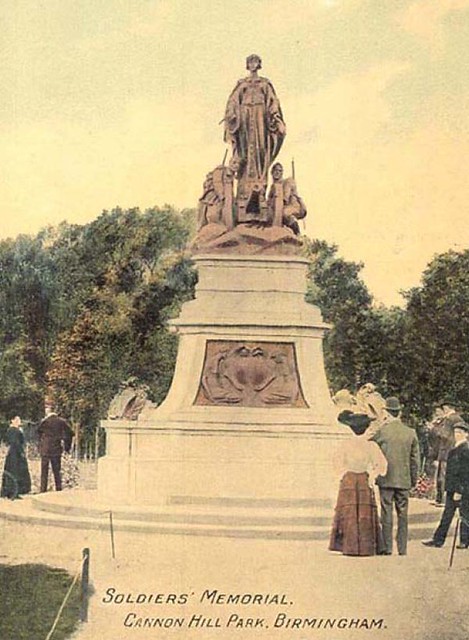Work begins on the restoration of the South Africa War memorial in Cannon Hill Park


Work is to begin in the coming weeks to restore the South African War memorial in Cannon Hill Park, Moseley. This follows a successful application to the War Memorial Trust for £15,000, plus match funding of £15,000 from the Council.
The memorial is a large and impressive feature at the northern end of Cannon Hill. However, the years have not been kind to it: features have been stolen; underground movement has cracked the granite plinth; a lack of pointing is allowing water ingress into the plinth causing more damage and finally, the bronze sculptures have lost their protective coating and now slowly corroding away.
The South African War memorial was unveiled on 23rd June 1906 to remember the servicemen from Birmingham who were killed in the Second Anglo-Boer War of 1899 to 1902. Similar other South African War memorials erected up and down Britain were the first known example of mass raising of war memorials in this country. The scale was unprecedented, no previous war, even those of a similar scale such as the Crimea (1854-1857) and the Napoleonic Wars (1798-1815), resulted in such a popular and public expression.
The Cannon Hill Park South African War Memorial was design by Albert Toft who would go on to design the King Edward VII stutue (now in front of Baskerville House) and the bronze allegorical figures around the Hall of Memory, Centenary Square.
This memorial portrays both war and peace, featuring two soldiers at either side of a gun carriage – one represents Courage, the other Endurance. Standing above the two solders is a female figure holding a shield showing the City Arms and an olive branch.
On three of the four sides of the granite plinth, are bronze plaques with the names of the Fallen, while the fourth face contains a bronze bas-relief showing two figures representing Grief and Sympathy.
The four corners of the granite plinth did contain bronze figures which we believe were eagles, but we have been unable to find any close-up photos to confirm their design.
As mentioned above a number of features have been stolen, these include: the four eagles at the corners of the granite plinth; the olive branch held by Peace; the rifles and bayonets on the backs of the two solders.
If you look at the four bronze plaques on the granite plinth, you will see where scrap metal thieves have tried to crow-bar them off – the granite has been damaged and the bronze plaques bent in places.
The restoration work will do the following:
- Restore the bronze features back to their original bronze finish, not the present green corrosive coating. The bronze features will also have a protective coating to stop any further corrosion.
- The granite plinth will be cleaned, carefully repointed and any missing sections of granite re-instated.
- The olive branch for the Peace figure will be reinstated. We have good quality photographs which we can use to create a replica.
I am trying to find the extra £2,000 to fund the re-creation of the rifles and bayonets, but made in plastic resin.
We don’t have any detailed photos of the eagles that were around the base, so we are unable to recreate these.
We hope to have the restoration work completed by the end of March.

1 Comments:
This is great news Martin. It would be great to see more monuments and statues brought back to life in the city. Birmingham has been criticised for many years as neglecting its forefathers, I think a memorial in a prominent position can help remind people of the great and good who made Brum into such a successful city of trade, innovation and industry. One statue which I believe is no longer displayed in the city is Rowland Hill (postal reformer & inventor of the postage stamp).
Such an important fellow, taken from Wikipedia "There are three public statues of him. The first, sculpted by Sir Thomas Brock and unveiled in 1881, stands in the town of his birthplace, Kidderminster. The second, by Edward Onslow Ford stands at King Edward Street, London. The third, less known, by Peter Hollins, used to stand in Hurst Street, Birmingham but it is currently in the Birmingham Museum & Art Gallery store." - Can we not bring this back into a prominent position.
As a side note it would be great to see a few more fine quality memorials in the city centre to remind people of some of the city's true heros, such as Tolkien (possibly the world's most loved author), Fred Lanchester (inventor of so many advances in the automobile), William Mc Gregor (inventor of the football league), Joseph Sampson Gamgee (who created the surgical dressing which led to plasters and so on), Alexander Parkes (accredited with inventing celluloid), Sir Francis Galton (inventor of the weather map and finger prints to name but a few), Elkington Bros (pioneered electroplating which spread around the world and which had a profound effect on manufacturing), Lewis Paul and John Wyatt (inventors of the cotton spinning machine and founders of the first ever cotton mill).
If money is tight you could have a fundraiser for each commission.
Post a Comment
<< Home